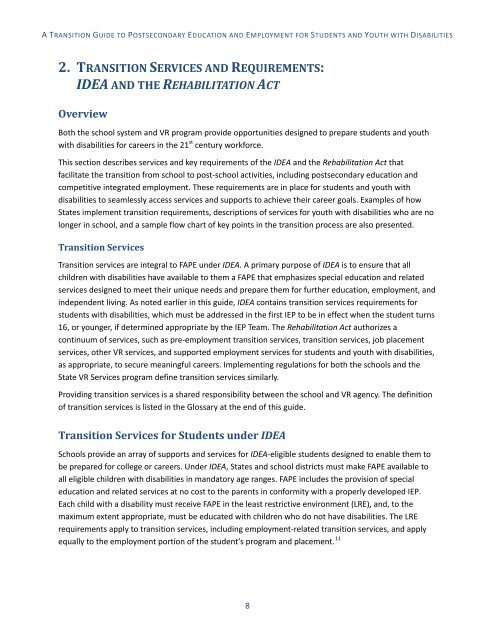TRANSITION GUIDE
2j9tM4H
2j9tM4H
You also want an ePaper? Increase the reach of your titles
YUMPU automatically turns print PDFs into web optimized ePapers that Google loves.
A <strong>TRANSITION</strong> <strong>GUIDE</strong> TO POSTSECONDARY EDUCATION AND EMPLOYMENT FOR STUDENTS AND YOUTH WITH DISABILITIES<br />
2. <strong>TRANSITION</strong> SERVICES AND REQUIREMENTS:<br />
IDEA AND THE REHABILITATION ACT<br />
Overview<br />
Both the school system and VR program provide opportunities designed to prepare students and youth<br />
with disabilities for careers in the 21 st century workforce.<br />
This section describes services and key requirements of the IDEA and the Rehabilitation Act that<br />
facilitate the transition from school to post-school activities, including postsecondary education and<br />
competitive integrated employment. These requirements are in place for students and youth with<br />
disabilities to seamlessly access services and supports to achieve their career goals. Examples of how<br />
States implement transition requirements, descriptions of services for youth with disabilities who are no<br />
longer in school, and a sample flow chart of key points in the transition process are also presented.<br />
Transition Services<br />
Transition services are integral to FAPE under IDEA. A primary purpose of IDEA is to ensure that all<br />
children with disabilities have available to them a FAPE that emphasizes special education and related<br />
services designed to meet their unique needs and prepare them for further education, employment, and<br />
independent living. As noted earlier in this guide, IDEA contains transition services requirements for<br />
students with disabilities, which must be addressed in the first IEP to be in effect when the student turns<br />
16, or younger, if determined appropriate by the IEP Team. The Rehabilitation Act authorizes a<br />
continuum of services, such as pre-employment transition services, transition services, job placement<br />
services, other VR services, and supported employment services for students and youth with disabilities,<br />
as appropriate, to secure meaningful careers. Implementing regulations for both the schools and the<br />
State VR Services program define transition services similarly.<br />
Providing transition services is a shared responsibility between the school and VR agency. The definition<br />
of transition services is listed in the Glossary at the end of this guide.<br />
Transition Services for Students under IDEA<br />
Schools provide an array of supports and services for IDEA-eligible students designed to enable them to<br />
be prepared for college or careers. Under IDEA, States and school districts must make FAPE available to<br />
all eligible children with disabilities in mandatory age ranges. FAPE includes the provision of special<br />
education and related services at no cost to the parents in conformity with a properly developed IEP.<br />
Each child with a disability must receive FAPE in the least restrictive environment (LRE), and, to the<br />
maximum extent appropriate, must be educated with children who do not have disabilities. The LRE<br />
requirements apply to transition services, including employment-related transition services, and apply<br />
equally to the employment portion of the student’s program and placement. 11<br />
8


